Intel's Core 2 Extreme & Core 2 Duo: The Empire Strikes Back
by Anand Lal Shimpi on July 14, 2006 12:00 AM EST- Posted in
- CPUs
Application Performance using SYSMark 2004 SE
We'll kick off our look at general application performance with SYSMark 2004 SE and as always, and we'll look at the overall score as well as the scores in each of the two suites - Internet Content Creation and Office productivity.
As we saw in our last preview of Intel's Core 2 Extreme processor, it posted SYSMark scores that were well beyond anything either AMD or Intel had been able to deliver in the past. With the final version of Core 2 silicon in our hands and a more stable/tweaked platform, we got even better numbers out of Conroe:
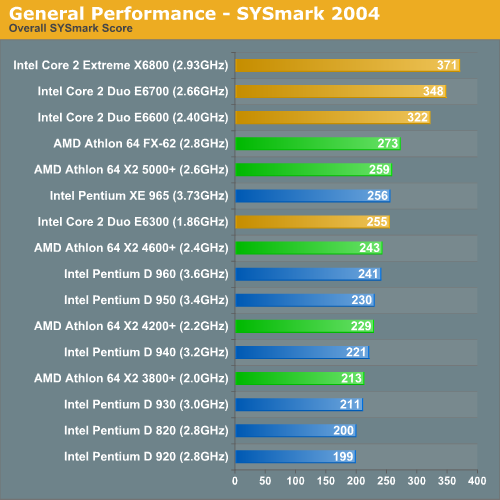
At the high end, the Core 2 Extreme X6800 was just under 36% faster than the Athlon 64 FX-62. In fact, even the $316 E6600 was around 18% faster than AMD's fastest. To add even more insult to injury the slowest Core 2 Duo in the test, the 1.86GHz E6300 is barely slower than AMD's fastest Athlon 64 X2.
The old Intel lineup of Pentium D processors is truly an embarrassment. Only the Extreme Edition 965 is remotely competitive and even then it can barely outperform the $183 E6300.
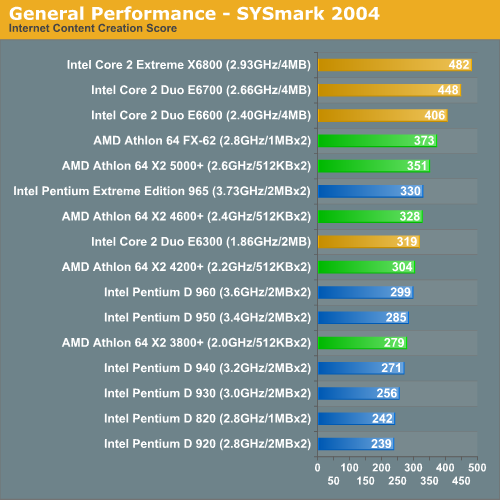
Drilling down into the SYSMark scores we've got the overall ICC results, which honestly are not much different than the overall scores we saw above. The Core 2 Extreme X6800 holds a 29% performance advantage over the FX-62 and once again, and the E6600 is able to outperform AMD's best by over 8%.
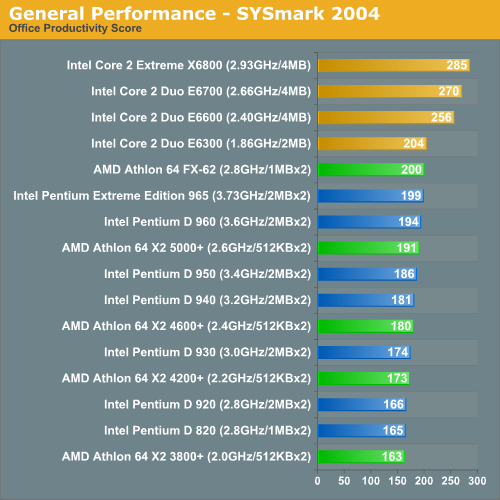
Intel's Core 2 performance domination continues in the Office Productivity portion of SYSMark 2004, with the Core 2 Extreme X6800 maintaining a 42.5% performance advantage over the FX-62. This time around, even the E6300 manages to remain competitive with the FX-62. This is Intel's new $183 part offering performance equal to that of AMD's $1,000 flagship FX processor; it's going to take a lot for AMD to recover from this deficit.
The individual SYSMark 2004 SE scores are graphed below if you're interested. The data is used in calculating the overall scores we've already discussed above:
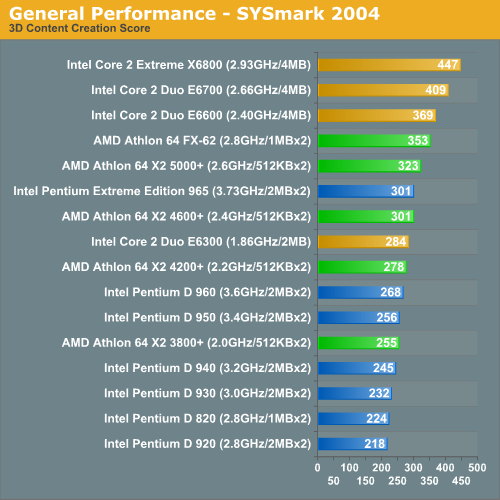
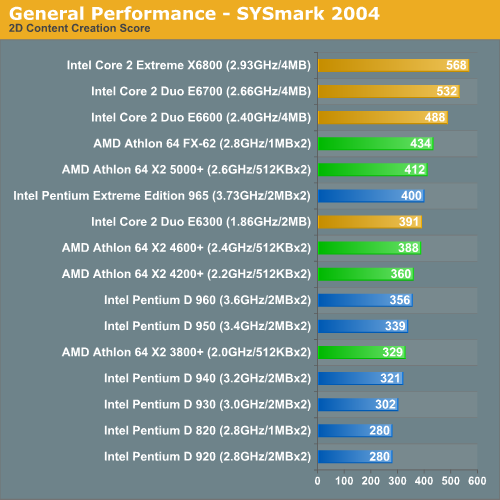
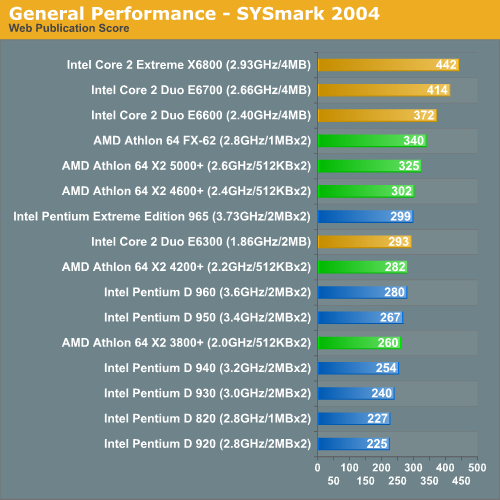
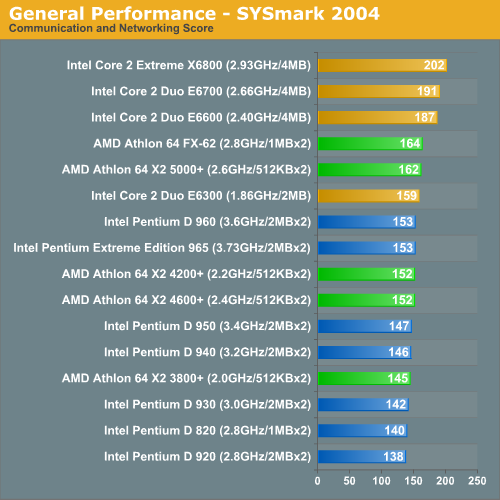
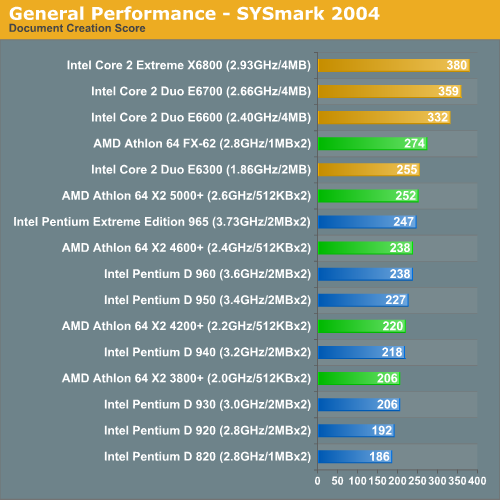
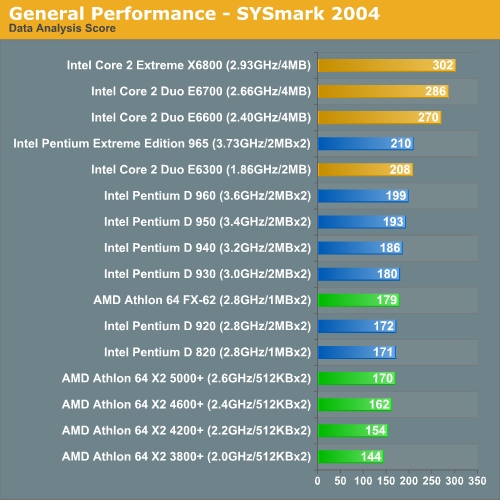










202 Comments
View All Comments
soydios - Friday, July 14, 2006 - link
Awesome article, as always from AT. Between the article and the 100+ comments above this one, almost all my Conroe questions have been answered.;)
johnsonx - Friday, July 14, 2006 - link
Wow is all I can say. I don't think there's ever been a performance jump quite like this. AMD will still do ok (not win mind you) on the low-end, where most people live, but the mid-range and high-end is so overwhelmingly in Intel's camp now there's just no comparison. AMD would have to go to 3.4Ghz+ to even be competitive (and still not win mind you).My office computers will continue to be AMD Sempron for the forseeable future (AM2 from now on of course), but next time someone wants a CAD box I don't see how I can quote anything but Core 2 Duo.
Also, loved the dinner table analogy on page 13.
crimson117 - Friday, July 14, 2006 - link
http://www.tgdaily.com/2006/07/13/dell_xps700_to_f...">http://www.tgdaily.com/2006/07/13/dell_xps700_to_f..."Grapevine (TX) - On the day Intel announces its next generation of Conroe desktop processors - which is expected within days - Dell Computer will upgrade its top-of-the-line XPS 700 desktop computer model to offer not only an overclocked Core 2 Extreme CPU, but also the option of two Nvidia GeForce 7900 GTX cards in SLI mode. These will apparently replace the Pentium Extreme processor and GeForce 7900 GS options currently available, and will be in addition to the Aegia PhysX accelerator already offered."
epsilonparadox - Friday, July 14, 2006 - link
Probably an Nf4 chipset since there are motherboards with conroe support using Nf4.Avalon - Friday, July 14, 2006 - link
This is one fine architecture. It wound up performing as well as I had suspected it would. Definitely wow.cgrecu77 - Friday, July 14, 2006 - link
I gambled by purchasing a A64 3700+ a few weeks ago when it dropped to under 150 ...If I were to upgrade to the cheapest solo I would probably have to pay 500 dollars or more (new cpu, mb and memory) and I will probably get ~ performance in games. I stopped overclokcing a long time ago (except for maybe 10%) because I am tired of my new system becoming unstable after 4 months (plus I don't really need it anymore since nothing I do is really cpu limited).
98% of people actually buy the cheapest CPUs in a range (A64 2800-3200, x2 3800, C6300). That's where the real competition will be and frankly I'm not impressed at all, A64 is an ~3years old processor and intel's newest product can only beat it by 20%? As far as I can remember the Athlon 3200+ was even worse in comparison to P4 3,2 Ghz and most people still bought the 2500+ Bartons ... So I wouldn't worry too much if I were an AMD stock holder, especially that it looks like Opterons still have no competition in the multi cpu servers (more than 2 ...).
After all, if Dell decided to use AMD NOW of all times it must mean something, they probably had access to these benchmarks a little earlier than Anand had ... :)
One thing I would have expected to see for such a new CPU that is supposed to carry the Intel flag for the next 2 years is 64 bit performance. This is probably the last year when 32bit OSes have the upper hand, starting with Vista most people will take advantage of their 64bit cpus. Once the majors concentrate on 64 bit drivers you can be sure that they will gradually take resource from the 32 bit development and the balance will shift very quickly ... If A64 has even a 10% advantage over the Cores combined with the .65 switch it will probably balance the equation to the point where core and a64 will have similar performance per clock ...
dargaard - Saturday, July 15, 2006 - link
http://babelfish.altavista.com/babelfish/trurl_pag...">Some Conroe problems (??) with 64 bitdev0lution - Friday, July 14, 2006 - link
First off, why mention Core Solo when it's totally unrelated to this article and any of the comments?
Second, socket 939's days are already numbered. You'd have to pay the same $500 to upgrade to the AM2 processors benched in the article, so mentioning this as a diss to Core 2 Duo is pretty weak.
So you'd have the option of spending $500 to upgrade to a E6600 setup that would beat out a $1200+ AM2 setup. Sounds like a no-brainer. And if you think AMD's going to slash prices below Intel's parts I don't think you can hold your breath that long.
And 98% of people don't even build their own computers, they buy tier-1... who aren't making nearly that percentage of their systems with the lowest end parts.
Looks like I'll have a 3200, 3700 and 4000 (939 parts) for sale in the near future...
MrKaz - Monday, July 17, 2006 - link
OK.But if you dont want to spent more than 120$ for the processor, the Conroe looks expensive.
aznskickass - Friday, July 14, 2006 - link
Dude, 20% is a HUGE margin when you are talking competitive benchmarks.When A64 was released back in 2003 it had about a 10% edge on the P4 and people were lauding it for it's leap in performance, and rightly so, considering the AXPs were getting beaten by 10%, so it was a 20% turnaround altogether.
This time around, it's even more impressive from Intel as they have turned a 10 - 20% performance deficit into a 20% advantage, you really can't expect much more than that, can you?
What did you expect Intel to do, double A64 performance? I'm sure if they ran their chips @ 4GHz/400FSB they might be able to get close to that, but what is the point when you have beaten your competition so convincingly already?